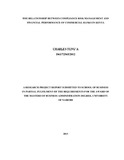| dc.description.abstract | The Banking sector has undergone significant transformation and continues to improve with new regulations and guidelines seeking to maintain stability. Compliance risk is the risk of legal or regulatory sanctions, material financial loss, or loss to reputation that a Bank may suffer as a result of its failure to comply with laws, regulations, rules, related self-regulatory standards, best business practices, internal policies and procedures and codes of conduct applicable to its banking activities. The objective of this study was to assess the relationship between compliance risk management and financial performance of commercial banks in Kenya. The research adopted a descriptive survey design on a population of the 43 commercial banks in Kenya. The study utilized both primary and secondary sources of data. Data analysis was done using the facilities for descriptive methods on the Statistical Packages for Social sciences (SPSS).
From the findings, it is clear that the banking industry in Kenya is growing a steady rate and consequently the players need to comply with certain regulations in the market. In addition accountability contributes more to financial performance in the commercial banks in Kenya. Further, control environment as compliance risk management practice influences financial performance in Kenyan commercial banks. The findings indicated that banks’ audit control environment has a significant positive relationship with financial performance. In addition, control environment and accountability are significantly positively related; hence, they influence the operations of commercial banks.
The study recommended that Commercial banks in Kenya should maintain and strengthen control environment in order to increase their financial performance that enhances better operations in the financial market. The banks also need to improve their liquidity level through increasing their current assets that can easily be converted into cash. This level of assets should be above the liabilities in order to meet the creditors’ demands when there is need. Finally, there is a need to consider interviewing customers of the commercial bank in Kenya so that their views are also captured instead of bank staff as in this case. | en |

